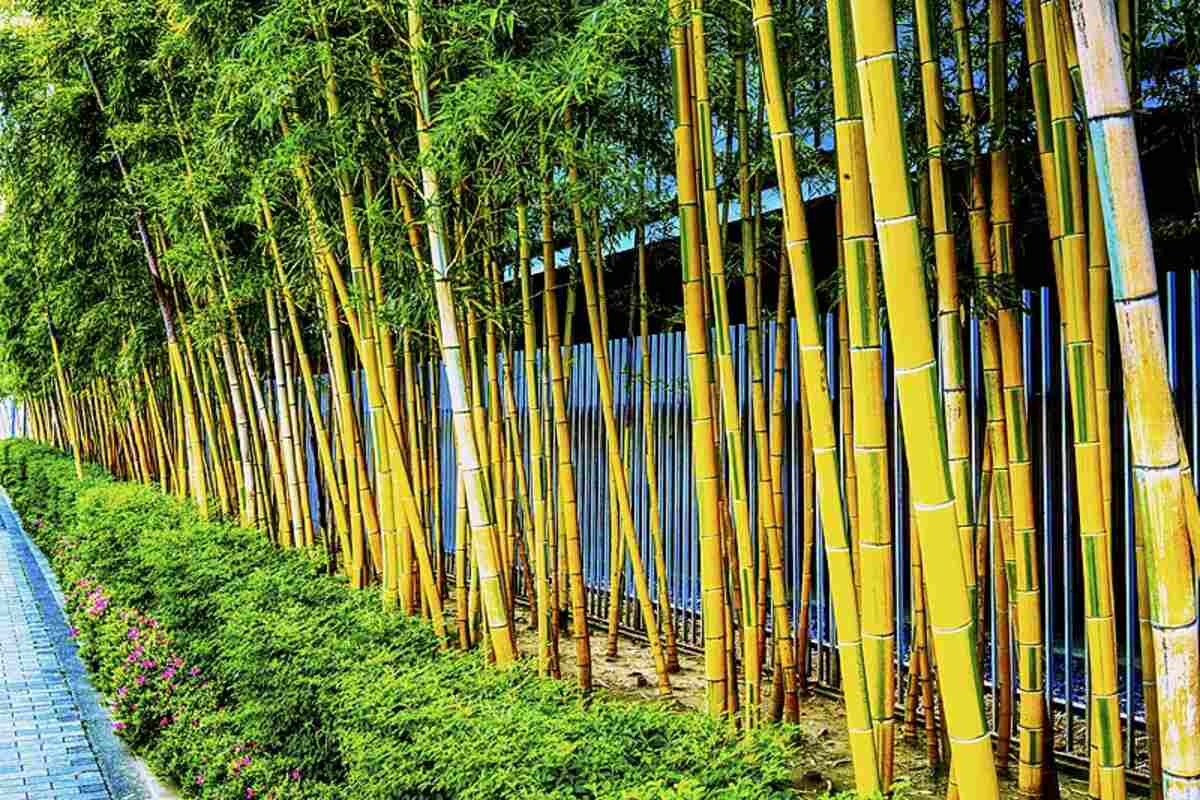
Bamboo can be a delightful addition to your landscape. Homeowners love bamboo for its tranquil aesthetic, and its fast-growing shoots make it ideal for privacy. However, living with a beautiful, invasive species can be a sweet and sour experience. How do you remove bamboo from your yard when it starts invading your garden or neighbor’s lawn?
When left unchecked, bamboo can take over your yard. If you’ve lost control over this resilient, persistent plant, you’ve come to the right place. This article will show you how to remove bamboo from your yard and how to contain your bamboo in its designated areas.
Bamboo Basics
Bamboo is amazing. It’s the fastest-growing plant on the planet. Full-grown bamboo can reach sixty feet tall and produce 35% more oxygen than trees. Bamboo is used in construction, clothing, and paper production. Bamboo even makes excellent firewood.
But despite its cool traits, bamboo can be a nightmare in the yard. Bamboo is grass (not a tree), and just like grass, bamboo can spread and take over.
Before you can remove this aggressive plant from the yard, you’ll need to learn some basic bamboo terminology:
- Bamboo stems are called culms.
- The root system is guided by rhizomes, an underground stem that travels outward, dispersing roots. Rhizomes are how bamboo spreads. Bamboo rhizomes are usually 2 to 5 inches underground; however, mature rhizomes can reach twelve inches deep, so you may need to dig deep. Mature rhizomes can produce roots that grow 20 inches deep.
Bamboo is typically categorized as either clumping or running:
Clumping Bamboo
This bamboo is less invasive and has shorter rhizomes than running bamboo, making it easier to contain. It shows slow vertical growth before producing a culm.
Clumping bamboo varieties include:
- Gracilis
- Alphonse Karr
- Ghost
- Oldhamii
- Himalayan Weeping
- Nepalese Blue
- China Gold
Running Bamboo
Running bamboo is more invasive and harder to control than clumping bamboo. Its rhizomes spread horizontally, sending up multiple culms and quickly establishing bamboo groves.
Running bamboo varieties include:
- Marbled
- Square
- Golden
- Running Black
- Pygmy
- Dwarf Green Stripe
Why Remove Bamboo?

There are various reasons to remove bamboo from your lawn. Whether bamboo is creeping under the fence from your neighbor’s yard or you decide on a different aesthetic for your garden, bamboo removal can be a chore. So why deal with it?
Here are three common reasons homeowners elect to remove bamboo from their properties:
- It’s an invasive species: bamboo can hinder the growth of other plantlife and threaten biodiversity.
- It grows rapidly: left unchecked, some species can grow one meter a day.
- It’s difficult to remove after it begins to spread: removing bamboo rhizomes from an established bamboo grove is tedious manual labor.
How to Remove Bamboo
The first step of any bamboo removal method is to cut the culms to ground level. Bamboo is strong but can be cut with a handsaw, chainsaw, or lopper. After cutting the culms to ground level, sever the rhizomes with a shovel or spade. By severing the rhizomes, the roots will perish, and your bamboo will stop spreading.
After cutting the culms and severing the rhizomes, you’re now prepared to target the bamboo with the various methods listed below. Bamboo is strong and resilient, so trying multiple approaches, multiple times is your best bet for DIY bamboo removal. Feel free to pick and choose the methods that work best for you and your yard. To overcome this persistent plant, you’ll need consistency.
Method No. 1: Mow Over New Growth
When new sprouts emerge, you can mow over them with your lawnmower. Mowing discourages regrowth and new bamboo sprouts are easier to cut. While this method does discourage new growth, it can take 2 to 3 years for a noticeable reduction in new growth.
Method No. 2: Herbicides
Another method of bamboo removal is to use herbicides. Herbicides like Roundup weed and grass killer can destroy the plant within two weeks. This method is most effective after the culms are mowed and regrow to a height of 3 feet, or until the leaves expand.
Opt for herbicides containing glyphosate, as they are the most effective. Pour the herbicide down the hollow stems or over the exposed rhizomes, and the herbicide will kill the plant. After the herbicide has killed the plant, it will be easier to remove the remaining plant material from the ground. You can dig up or mow over the remaining cut culms.
Avoid using herbicides near water, and be advised this method only kills one stalk at a time. Like all bamboo removal methods, consistency is key.
Method No. 3: Add Boiling Water
Another removal method is to pour boiling water on the exposed rhizomes. Using a shovel or spade, remove the soil to expose the rhizomes. Then, pour the water over the rhizomes. Boiling water stops future growth, but you’ll need to be consistent. Be careful not to burn yourself when transporting the water to your yard!
How to Contain Bamboo

So far, this article has covered bamboo as an invasive problem to be eradicated. However, bamboo can be a beautiful and tranquil addition to your garden. Luckily, there are ways to control bamboo growth and incorporate this plant into your habitat.
Potting
The simplest way to contain your bamboo is in a pot. When potting bamboo, choose a sturdy container, as bamboo roots can crack the plastic. Be sure your container has proper drainage, and soak the bamboo’s rhizomes. Soaking the bamboo for twenty minutes before planting allows water to reach the root ball. Pot your bamboo with 50/50 compost and potting mix and water regularly.
Rhizome Barrier
Installing underground rhizome barriers is a great way to incorporate bamboo into your landscaping. A 60-millimeter polypropylene (PP) or 80-millimeter high-density polyethylene (HDPE) barrier stops rhizomes from spreading and protects your other plants.
Dig a 24- to 30-inch deep trench around your bamboo. Slip a 30- to 36-inch wide barrier into the trench, with 6 inches of material remaining above ground. This above-ground protection will ensure your bamboo doesn’t grow over the barrier and continue to spread.
Pro Tip: If your barrier has corners, seal or clamp the joints together. Otherwise the rhizomes might grow through the cracks.
Berm and Trench Method
Suppose potting your bamboo doesn’t interest you, and rhizome barriers are too expensive. In that case, you might be interested in the berm and trench method.
In this method, you will dig a trench around your bamboo so you can sever rhizomes as they begin to stray outside the berm (the mound of soil containing your bamboo plant).
This method requires diligent monitoring of your bamboo. Still, it’s an effective method, especially if you prefer the taller running varieties.
FAQ About Bamboo Control
Although smothering may prevent some new growth, bamboo rhizomes can continue spreading beyond the covered area.
Rhizomes are easiest to cut during the summer and early fall. At other times of the year, these root systems stiffen and become difficult to cut.
The rate of propagation depends on the species of bamboo. Larger running bamboo species, such as Golden bamboo, can spread over 15 feet a year.
When to Call a Professional
If ceaseless culms and resilient rhizomes have you feeling bamboozled, there’s no shame in calling in a professional landscaper to remove the bamboo.
Need a hand mowing down those new bamboo shoots? Hire a landscape professional to take care of the dirty work for you.
Main Image Photo Credit: Mycomp / Wikimedia Commons / CC BY-SA 4.0